


Lake Van is one of the largest alkaline lakes on Earth, but today it has another superlative: Tournament Earth 2021 champion.
This year, readers, astronauts, and NASA staff chose 32 photos — shot by the astronauts from the International Space Station — to compete in our tournament. Lake Van was slotted as a #8 seed, but knocked out higher seeded fishing boat lights (#1 seed), Elba at night (#4), Typhoon Maysak (#2), the castellanus cloud tower (#6), and finally Stars in Motion (#3) to win the crown. Across the five rounds, more than 930,000 ballots were cast, a record in the history of our Tournament Earth competitions.
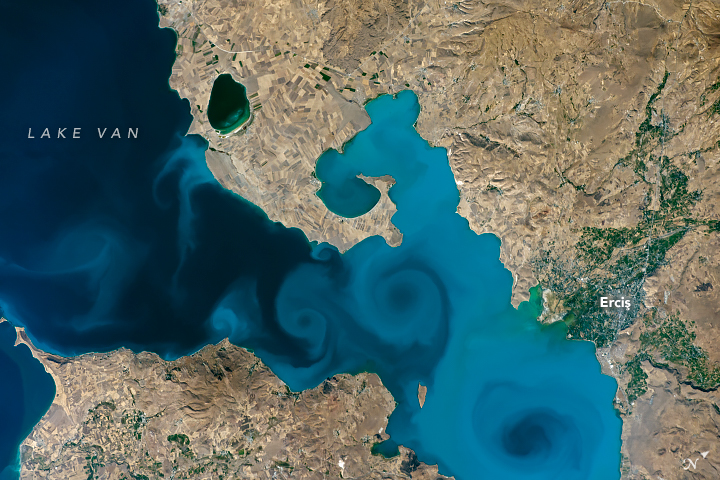
The winning image, showing a northeastern portion of the lake, was shot by astronaut Kate Rubins while orbiting on the space station in September 2016. Lake Van is an endorheic lake—it has no outlet, so its water disappears by evaporation—with a pH of 10 and high salinity levels. Turbidity plumes, which appear as swirls of light- and dark-toned water, are mostly comprised of calcium carbonate, detritus, and some organic matter. The lake is also the largest water body in Turkey.
Lake Van also has quirkier characteristics. According to legend, it is the home for a lake monster popularized in Turkish folklore. Akin to the Loch Ness monster, the Lake Van monster is rumored to look like an ancient marine reptile such as a plesiosaur. No monster-like creature has been confirmed, although archeologists have found parts of a 3,000-year-old castle buried under the lake’s waters.
The Lake Van region is also home to a special cat breed known as the Van cat. The felines have been seen swimming in Lake Van and are known for their almond-shaped eyes, often of different colors.
For the past five weeks, the competition has caught the eye of several Turkish news outlets, government officials, and Turkish citizens expressing love for their home. Other readers liked the photo due the simple beauty as a single photograph. The mayor of Van has since invited astronaut Rubins to visit.
The tournament may be over, but be sure to come back as we bring you a new view of our home planet every day of the year. If you really like astronaut photos, come back for a new one every weekend. To view other photos shot from the space station, visit the EO Astronaut Photography Collection and the Gateway to Astronaut Photography of Earth.
If you want to learn about the experience of observing the Earth from the International Space Station or about how astronauts are trained to observe our planet, watch our Picturing Earth video series above.
Thank you for voting in this year’s #TournamentEarth. We hope to bring you more competitions like this in future months and years.
It is that time of year again…Tournament Earth is back! This time, the theme is astronaut photography. For more than 20 years, astronauts have been shooting stunning photos of Earth from the International Space Station that highlight the planet’s beauty, complexity, and vulnerabilities.
So which are the most unforgettable photographs of Earth taken from the space station? Over the next five weeks (March 8-April 13), you can help decide.
The first round has already begun. Cast your vote here: https://earthobservatory.nasa.gov/te
While you wait for the Round 1 results, download the bracket here and challenge your friends. After you fill out that bracket, post your predictions in the comment thread for which four photos will make the semifinals and which one will be crowned champion. We can’t offer prize money or a trip to the Moon, but bragging rights are forever if you can guess the eventual champion.
Also, bookmark this space. We will provide updates later in the tournament and highlight some of your predictions, commentary, and insights lower in the post. Just remember to use the hashtag #TournamentEarth and tag @NASAEarth on social media (we’re on Twitter, Facebook and Instagram) or we might not see your post.
If you are curious about the team behind the photos you see in Tournament Earth, check out our Picturing Earth video series.
Happy voting!
For more than 20 years, astronauts have been shooting photographs of Earth from the International Space Station. Before that, they looked down from Mercury, Gemini, Apollo, Skylab, the Space Shuttles, and MIR. They have brought us unique views of our home planet in all of its wonder, beauty, and ferocity. They have also made some interesting and timely science observations along the way.
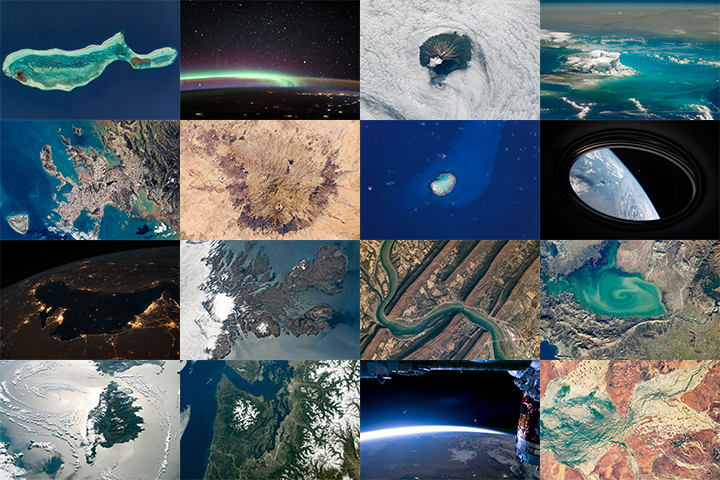
More than 1,000 of those photos have been published here on NASA Earth Observatory. We would like you to help us choose the best in our archives. In early March, we will launch Tournament Earth: Astronaut Photography, and we want you to be part of the selection committee.
From now through February 19, 2021, search our archives and point out the best photos shot by the astronauts. Post the URLs of your favorite photos in the comments section below.
Please choose images from these collections:
EO Astronaut Photography Collection
Visible Earth: Astronaut Photography
Please note that there are 30+ pages of images to scroll through — an internet rabbit hole of incredible beauty.
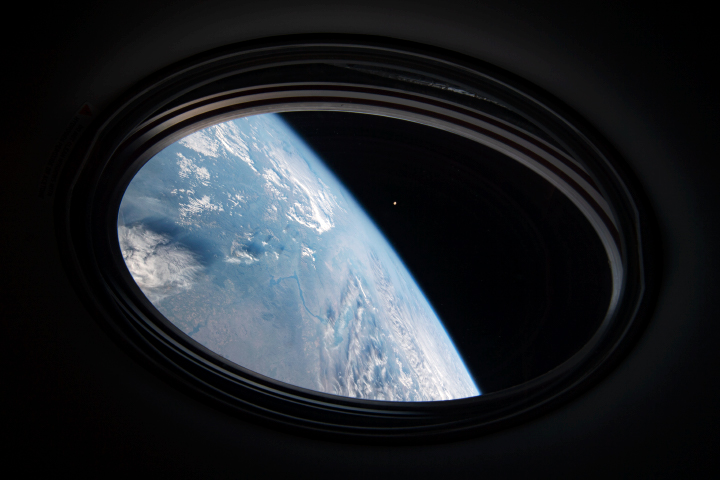
In March 2021, we will include some of your selections in Tournament Earth, a head-to-head contest to vote for the best of the best from our archives. Each week, readers will pick from pairs of images as we narrow down the field from 32 nominees to one champion. The Tournament Earth champion will be announced in early April.
So get browsing and get choosing. Then post your favorite URLs in the comments section by February 19.
If you want to learn more about how and why astronauts shoot photos of our planet — and the special training involved — check out our video series “Picturing Earth.”
Astronaut Photography in Focus
There have been two rounds of voting in Tournament Earth 2020, and two rounds of stunning upsets. Only two of the top eight seeds made it through. Night Lights? Snuffed out. Colorado River? Dried up. Caspian ice? Melted. Aerosols? Cleaned out. A river of tea? Gone cold. Dark side of the Moon? Someone broke the record. Iconic Earthrise? Didn’t make it to dawn.
Every time we run one of these tournaments, we are surprised by what catches the eyes of our readers. It is time to surprise us again. Cast your votes now in round three to pick the best four of the Earthly 8. Voting ends on April 13 at 9 a.m. U.S. Eastern Time. Check out the remaining competitors below.
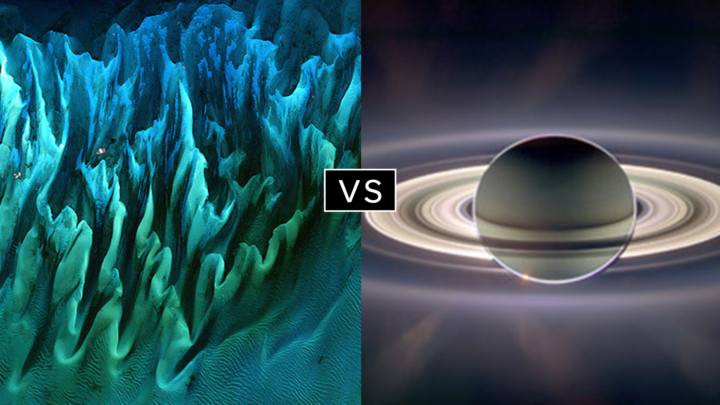
In round 1, Ocean Sand garnered the most votes overall and wiped out #4 seed and 2014 champion El Hierro Submarine Eruption, winning by the largest margin of any pairing (81 to 19 percent). In round 2, Sand beat the #1 seed, The Dark Side and the Bright Side, by a 57 to 43 percent margin.
A View from Saturn garnered the second highest vote total in round 1, besting Blooming Baltic Sea by 77 to 23 percent. In the second round, Saturn beat Sensing Lightning from the Space Station, 60 to 40 percent. In case you didn’t notice, Earth is visible in that Saturn image.
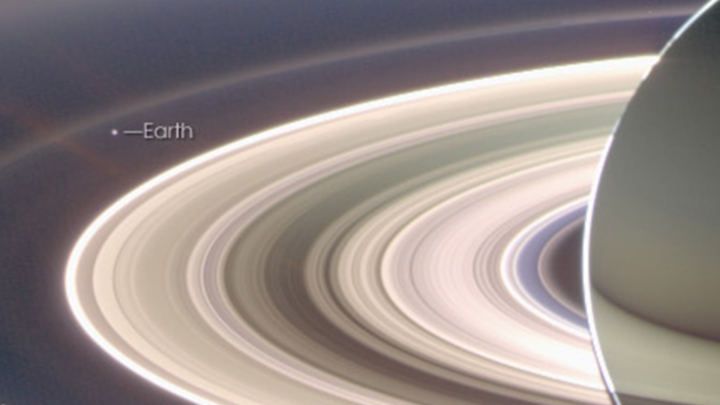
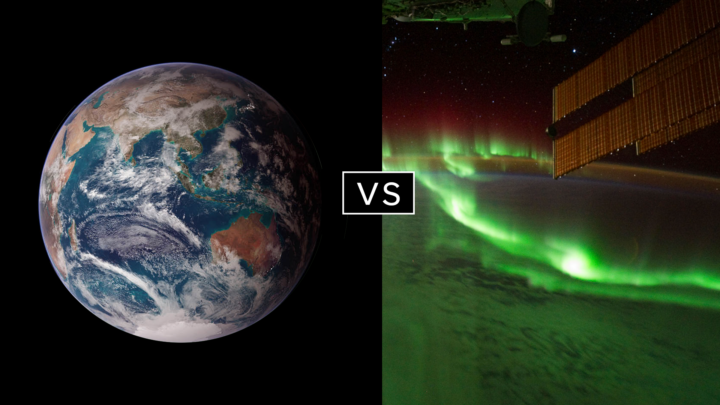
Twin Blue Marbles is the only #1 seed left in the tournament. In round 1, it captured 71 percent of the vote while besting Auroras Light Up the Antarctic Night. In round 2, Blue Marbles was the top overall vote getter and beat the iconic A Voyager Far from Home by 66 to 34 percent.
Fire in the Sky and On the Ground has pulled off two massive upsets. In round 1, it beat #2 seed Night Light Maps Open Up New Applications, 71 to 29 percent. In round 2, Fire beat the sentimental favorite and oldest image in Tournament Earth, All of You on the Good Earth — the original Blue Marble photo (1968) and the inspiration for the first Earth Day (1970). The voters chose the auroral fire over Apollo 8 fame by 57 to 43 percent.
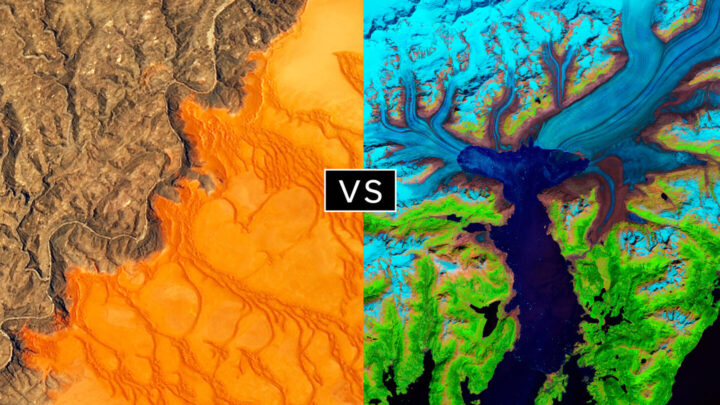
This bracket pairs two low seeds that knocked off highly ranked opponents. #8 seed Where the Dunes End topped #1 A Curious Ensemble of Wonderful Features in round 1 (63 to 37 percent), then topped #4 Roiling Flows on Holuhraun Lava Field (56 to 44).
The false-color image Retreat of the Columbia Glacier got 57 percent of the vote to beat Icy Art in the Sanikov Strait in round 1. Round 2 was a close call: Columbia barely eclipsed Antartica Melts Under the Hottest Days on Record (51 to 49 percent).
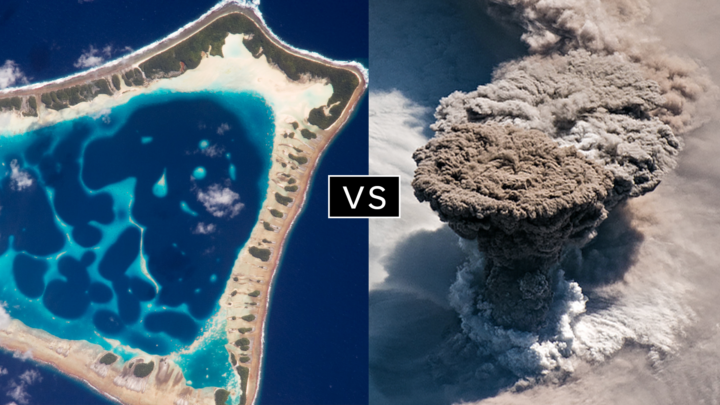
Another pair of Cinderella stories here. Atafu Atoll outclassed #1 seed Some Tea with Your River in round 1 by 75 to 25 percent. In round 2, it collected the second most votes overall, beating #5 Making Waves in the Andaman Sea 62 to 38 percent.
Raikoke erupted in round 1, collecting 72 percent of the vote while beating #3 Awesome, Frightening View of Hurricane Florence. In round 2, the volcanic plume smothered #2 Just Another Day on Aerosol Earth, 61 to 39 percent.
Since its launch on the web in April 1999, NASA Earth Observatory has published more than 15,500 image-driven stories about our planet. In celebration of our 20th anniversary — as well as the 50th anniversary of Earth Day — we want you to help us choose our all-time best image.
For now, we need you to help us brainstorm: what images or stories would you nominate as the best in the Earth Observatory collection? Do you go for the most beautiful and iconic view of our home? the most newsworthy? the most scientifically important? the most inspiring?
Search our site and then post the URLs of your favorite Earth images in the comments section below. Please send your ideas by March 17.

In late March 2020, we will include some of your selections in Tournament Earth, a head-to-head contest to vote for the best of the best from our archives. Each week, readers will pick from pairs of images as we narrow down the field from 32 nominees to one champion.
The all-time best Earth Observatory image will be announced on April 29, 2020, the end of our anniversary year.
If you want some inspiration as you begin your search, take a look at the galleries listed below. Or use our search tool (top left) to find your favorite places, images, and events.
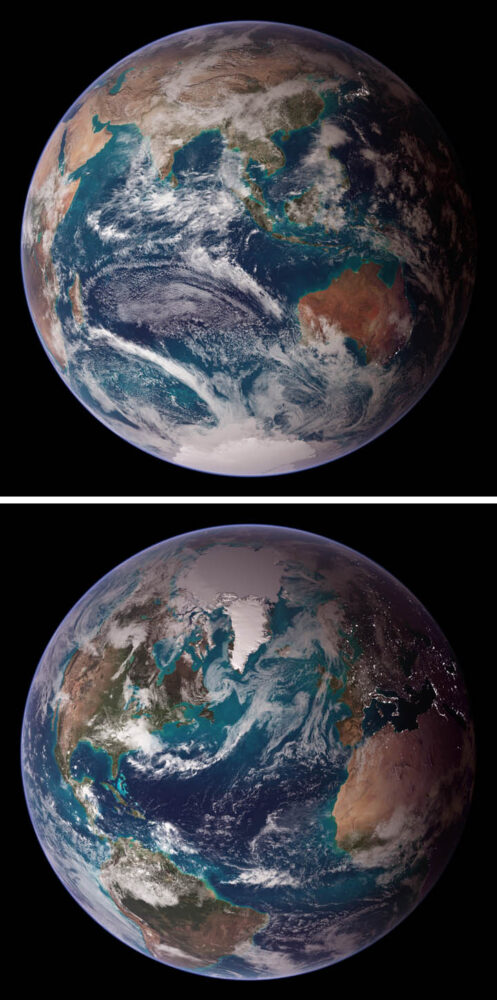
No, that is not a photograph of the death star orbiting Earth. It is the winner of NASA Earth Observatory’s 2016 Tournament Earth—the Dark Side and the Bright Side. The image shows the fully illuminated far side of the Moon that is not visible from Earth.
The images were acquired by the Earth Polychromatic Imaging Camera (EPIC) on the DSCOVR satellite, which orbits about 1.6 million kilometers (1 million miles) from Earth. EPIC maintains a constant view of the fully illuminated Earth as it rotates. About twice a year the camera captures images of the Moon and Earth together as the orbit of DSCOVR crosses the orbital plane of the Moon.

The Moon faced some stiff competition on its journey to the championship. In the course of the tournament, it faced a trio of hurricanes over the Pacific, the electric eye of Cyclone Bansi, an underwater volcano, and the wrath of Mount St. Helens. The final round came down to a slugfest between the Moon and an impressionistic bloom in the Baltic Sea caused by a profusion of cyanobacteria. When the voting was over, the Dark Side/Bright Side finished with 59 percent of the vote.
While we aren’t aware of any homecoming parades to honor the 2016 champion, watching the video above (or listening to all of Pink Floyd’s Dark Side of the Moon) seems like a fitting way to celebrate. The images in the movie below were taken over the course of five hours on July 16, 2015. The North Pole is toward the upper left, reflecting the orbital tilt of Earth from the vantage point of the spacecraft. The far side of the Moon was first observed in 1959, when the Soviet Luna 3 spacecraft returned the first images. Since then, several missions by NASA and other space agencies have imaged the lunar far side.
How did you fare in the opening round of Tournament Earth 2016? One of my favorite photos, showing Mauna Kea volcano has already gone down in defeat. The top seeds moved on to the next round with the exception of Laguna Colorado that fell to an upstart view of New Zealand in sunglint. What will happen in Round 2? Anything is possible. Polls are open for you to vote for the sixteen images that remain through Friday at 4:00 p.m. EDT / 8:00 p.m. UTC. Vote at http://earthobservatory.nasa.gov/TournamentEarth/
Here in the U.S., it’s election season. Don’t forget to vote.
For the second year in a row, an image from the Canary Islands took the championship of Tournament: Earth. In 2013, a submarine volcano near El Hierro Island was the crowd favorite. This year, it was a shot of the entire island chain that dominated the vote. When “Trailing the Canaries” faced “Activity at Kliuchevskoi” in the championship round, it wasn’t just a win for the Canaries image; it was a blowout. Of the nearly 50,000 votes cast, 96 percent went to the Canary Islands image.
To salute our many readers from the Canaries, we’ve combed through our archives and selected five of our all-time favorite images involving the island chain. They are posted below from oldest to newest. Click on each image for more details. Enjoy!
Dust over the Canary Islands (March 2009)
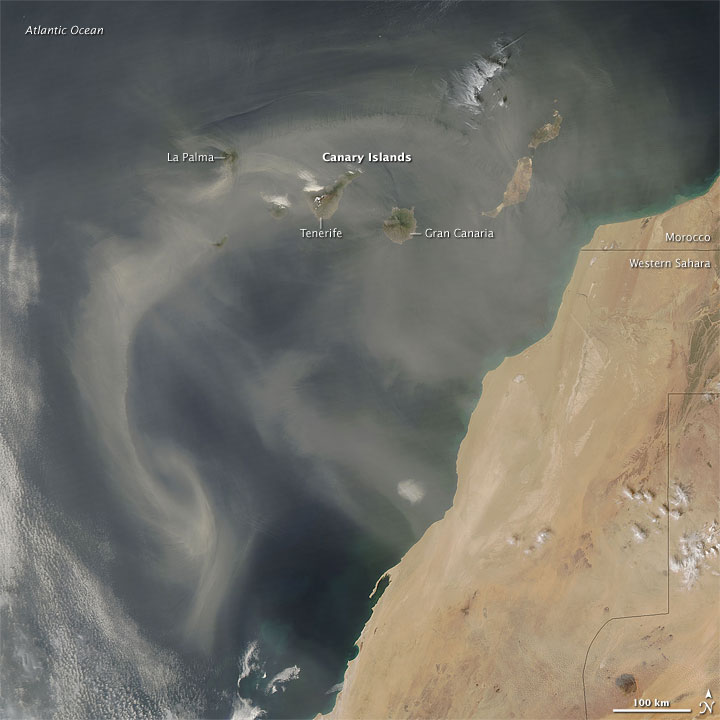
Sand and Tourism in Gran Canaria (January 2013)

El Hierro Submarine Volcano Eruption (2013 Tournament Earth Champion)

How is your bracket looking after the opening round of Tournament Earth? Unsurprisingly, top seeds Global Toll of Particulate Pollution (56.2 percent of votes), Snow Across Great Britain (50.7 percent), and Liege at Night (54.7) all dispatched weaker opponents in the first round of competition. The notable exception among the top seeds was Air Quality Suffering in China, which went down to eight-seeded Something Fishing in the Deep, Dark Ocean in a surprise loss in the events section, earning a mere 35.7 percent of votes. The other big upset of the opening round was seventh-seed Deforestation in Brazil knocking out second-seed Smoke Engulfs Singapore, with 50.9 percent of the vote. Haiyan’s Winds, Ship Tracks off North America, Fires in Colorado, and New Island Off Pakistan also went down in defeat against lesser opponents. Polls are open for you to vote for the sixteen images that remain through Friday at 4:00 p.m. EDT / 8:00 p.m. UTC. Vote at http://earthobservatory.nasa.gov/TournamentEarth/